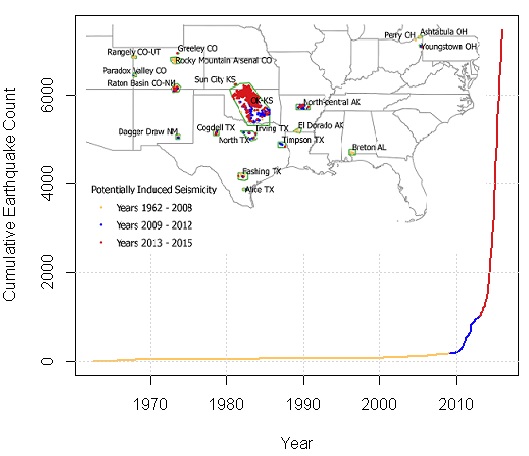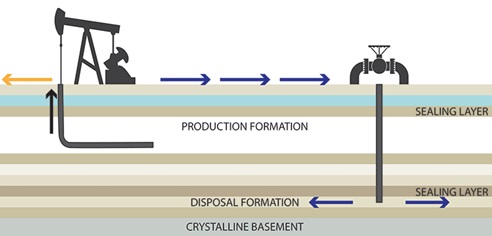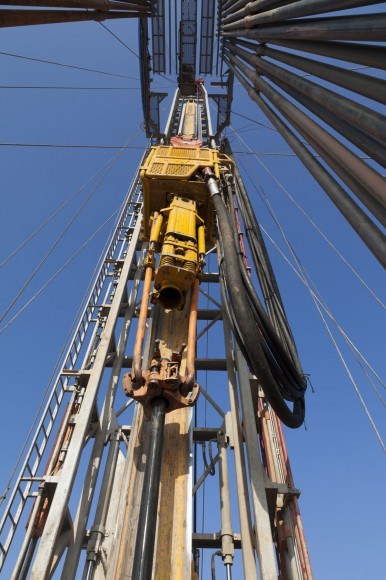In recent years, earthquake rates in regions of the historically seismically quiet central and eastern U.S. have risen at a remarkable pace. According to the latest research and scientific consensus, the culprit stems from impacts of wastewater disposal or enhanced oil recovery processes in deep injection wells—common procedures in oil and gas production.
Executive Summary
AIR Worldwide’s Dr. Claire Pontbriand describes some of the developing science behind induced earthquakes and hydraulic fracturing. She explains that it’s not the initial fracking activity but the reinjection of wastewater fluids into disposal wells that is of greater concern in terms of increased earthquake risk. Fluid pressure diffusing from the wastewater injection activities can increase pore pressure along existing nearby faults, bringing them close to rupture.In September 2016, a magnitude 5.8 earthquake near Pawnee represented the largest recorded earthquake in Oklahoma. The M5.7 2011 Prague, Okla., earthquake resulted in insured losses in excess of $10 million, and other potentially induced earthquakes have resulted in damage.
There are many questions surrounding these events in assessing their hazard and risk. What is the maximum possible magnitude of earthquake? What risk does future seismicity—the occurrence and distribution of earthquakes—pose to exposure in the central and eastern U.S.?
Most induced temblors are small, but they have been occurring in greater numbers and larger events have been recorded. In addition, considering what we know about seismotectonics—the relationship between historical earthquakes, faults and rock deformations driven by the active processes of plate tectonics—in the region, we cannot rule out the possibility of M7.0 or larger earthquakes in the central and eastern U.S.
Increased Seismicity
Fracking—hydraulic fracturing—is a technique used to increase the rate at which oil or natural gas can be recovered from deep in the earth. Slurry is pumped into wells at high pressure to fracture the rock and stimulate production. Waste fluids from fracking and other industrial activities are sometimes pumped deep underground into porous rock at disposal wells.
Although fracking does stimulate very small earthquakes, it has not been linked to larger magnitude, damaging earthquakes in the U.S. at this time. It is the injection of wastewater into deep disposal wells that is the greater cause for concern. Thus, although this hazard is often referred to as fracking risk, that is a common misnomer.
Over the past eight years, areas in the central U.S. where wastewater injection occurs—regions with historically low seismicity—have seen a remarkable increase in the frequency of earthquakes. In northern Oklahoma and southern Kansas, as well as regions in Colorado, New Mexico, Arkansas and Texas (see zones in figure below), the average instance of earthquakes of M2.7 and greater has risen from less than four per year from 1962–2008 to 210 per year from 2009–2013, a period during which these methods became widely used. Increases in detection capabilities and continued seismicity result in over 3,250 per year from 2013-2015.

There have been several examples of relatively larger induced earthquakes that have caused property damage, including the 2011 sequence of M5.0-M5.7 earthquakes in Prague, Okla.; the 2011 M5.3 earthquake in Trinidad, Colo.; the 2011 M4.7 earthquake in Guy-Greenbrier, Ark.; and the 2012 M4.8 earthquake in Timpson, Texas. The M5.8 quake experienced in Pawnee, Okla., in 2016 was the largest ever recorded in the state.
Establishing the Connection
Earthquakes are ground shaking caused by a sudden movement of rock in the earth’s crust. They occur when accumulated stress (the force acting on the fault plane) overcomes the friction holding one block of rock against another along the fault and one block slips relative to the other, rapidly releasing the pent-up energy.
In a dramatic reversal of its long-held position that they are due to natural causes, the Oklahoma Geological Survey (OGS) announced in 2015 that it is “very likely that the majority of recent earthquakes, particularly those in central and north-central Oklahoma, are triggered by the injection of produced water in disposal wells.” They added that “an increase in the frequency of earthquakes can be observed to follow the oil and gas plays [activities] characterized by large amounts of produced water.”

So, what is the frequency of induced earthquakes?
Without knowing of the existence and dynamics of stress/strain conditions (forces and deformations at work on the fault plane) of hidden subsurface faults and the nature and scale of pore pressure changes, it is difficult to answer this question. For one thing, stress changes at depth due to fluid injection may be transient, depending upon the state of fluid injection at the wells and the physical properties of the subsurface.

There is no simple predictor between influences caused by human activity—injection rate, cumulative injected volume, wellhead pressure, injection depth, etc.—and timing or magnitude of induced earthquakes.
The hazard posed by larger magnitude induced earthquakes is different from that of natural earthquakes, in part because induced seismicity acts on much shorter time scales. Although high-injection-rate wells (those pumping more than 300,000 barrels of wastewater a month into the ground) are more likely to be associated with earthquakes than lower-rate wells (according to a study by Weingarten et al., “High-rate injection is associated with the increase in U.S. mid-continent seismicity,” published in Science in 2015), in general there is no simple predictor between influences caused by human activity (e.g., injection rate, cumulative injected volume, wellhead pressure, injection depth, etc.) and timing or magnitude of induced earthquakes. Clear correlations have been noted only in a few cases.
What is the largest possible magnitude we can expect from induced events?
Some seismologists argue that the size of the initial earthquake depends upon the area impacted by the change in pore pressure and the scale of pore pressure change. However, there are others who argue that changing the state of stress on pre-existing faults in the vicinity of injection wells can trigger earthquakes beyond the fluid reach and, under favorable conditions, can lead to larger earthquakes than observed so far.
In such situations, if the size of the pre-existing fault can accommodate larger magnitude earthquakes, an induced earthquake could change the state of Coulomb failure stress on nearby fault segments and trigger larger magnitude earthquakes. This seems to be what happened in Oklahoma in 2011.
Can they be prevented?
Researchers, the federal government, energy companies and regulatory agencies are working to reduce the frequency and strength of induced earthquakes. Some states are regulating or monitoring the wastewater injection process to control the rate of induced seismicity.
In February and March 2016, for example, Oklahoma Corporation Commission’s Oil and Gas Conservation Division (OGCD) ordered injection wells in a huge swath of central and northern Oklahoma—where the greatest concentration of increased seismicity has been observed—to reduce injection volumes by 40 percent. In response to the M5.8 Sept. 3, 2016 quake—the largest recorded in the state—disposal wells were shut in and ultimately the OGCD designated a 1,116-square-mile area of interest (AOI) around the epicenter of the quake and extended restrictions to 67 wells.
Researchers at Stanford University mapping the natural geologic stresses across Oklahoma and Texas have learned that not all faults may slip in response to moderate pressure increases. The hope is that the stress maps they are developing can be matched with fault maps to indicate areas where wastewater injection will be least likely to trigger earthquakes.
The Risk to Property
Furthermore, most of the areas experiencing larger magnitude induced earthquakes have very low earthquake insurance penetration, suggesting that awareness of earthquake risk is low. (Arkansas has a higher take-up rate, probably due to the well-known New Madrid seismic zone.) Nevertheless, damage has been experienced and claims have been made.
To help companies assess the risk, AIR has developed an Induced Seismicity Model for the Central and Eastern U.S. that will be incorporated into the updated AIR Earthquake Model for the United States scheduled for release in 2017.
Looking Ahead




















 Florida Gets 8 New P/C Carriers After Insurance Market Reforms
Florida Gets 8 New P/C Carriers After Insurance Market Reforms  Viewpoint: Risks for D&O Insurers Exploring the New Frontier of Gen AI
Viewpoint: Risks for D&O Insurers Exploring the New Frontier of Gen AI  Uncertainty Keeps Prices Up; No Prior-Year Loss Development: Travelers
Uncertainty Keeps Prices Up; No Prior-Year Loss Development: Travelers  Triple-I: Insurance Economic Drivers Outperform Overall U.S. GDP
Triple-I: Insurance Economic Drivers Outperform Overall U.S. GDP 





